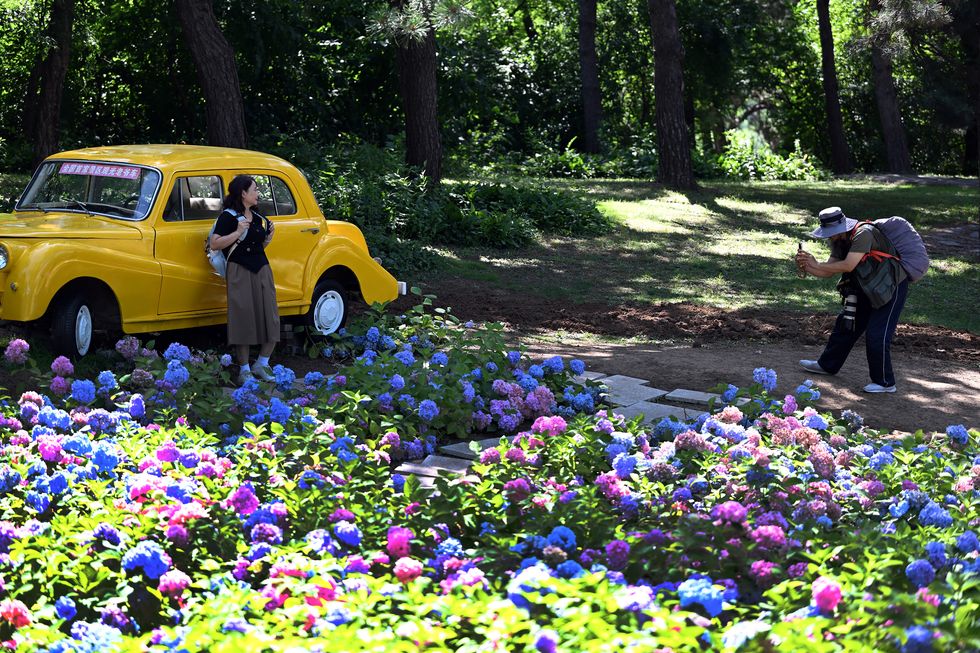For centuries, hydrangeas have charmed gardeners with their lush mounds of foliage and generous, cloud-like blooms in shades ranging from blush pink to electric blue. With origins in East Asia, particularly Japan, and the United States, they’re now often associated with East Coast summers, popular in vacation destinations like The Hamptons and Nantucket. Indeed, hydrangeas have evolved into modern-day favorites, gracing everything from manicured borders to wild woodland edges.
Though they exude elegance, hydrangeas aren’t as high-maintenance as their beauty suggests. These adaptable shrubs thrive out of direct sunlight, appreciate very frequent watering in their first year, and happily settle into a variety of environments, particularly when you’re using mulch and fertilizer appropriately. Whether you’re a gardening aficionado or someone who forgets to water the herbs on the windowsill, hydrangeas reward patience, with blooms that return year after year. With a few key tips (think: the right pruning time, soil pH awareness, and generous mulching), you’ll be enjoying full, colorful flowers and winning compliments before you know it.
Below is a fool-proof guide to growing hydrangeas.
Which variety of hydrangea is right for you?
Though all hydrangeas share some similarities, it’s important to understand the differences between varieties to properly care for them.
- Bigleaf hydrangeas (Hydrangea macrophylla) have the classic round, almost cloud-like shape. Initially native to Japan, their flowers range from blue to pink depending on the pH of the soil. Their blooms tend to be all sterile (round and flat).
- Panicle hydrangeas (Hydrangea paniculata) have more cone-shaped flowers. They come in a range of shades from white to cranberry. Native to East Asia and Russia, they bloom on shrubs and tree-like bushes. They are also generally all sterile.
- Smooth hydrangeas (Hydrangea arborescens) are also round, but smaller and flatter than Bigleaf hydrangeas. They’re native to the U.S., and can survive various climates and temperatures, making them a hearty option, particularly for first time gardeners. They are often light green or white and grow in sterile and fertile (small bunches that carry genetic data) bunches.
- Oakleaf hydrangeas (Hydrangea quercifolia) are wider; they generally also have lace cap petals in addition to fertile and non-fertile bunches. Originating in the South Eastern United States, they grown in fertile and sterile bunches.
- Climbing hydrangeas (Hydrangea anomala petiolaris) grow up to 25 feet tall (where other varietals don’t grow higher than four or five feet). The blooms are flatter than the big leaf bunches or panicle cones. Another East Asian variety, they have origins in Japan, Korea, and China. They also grow in fertile and sterile bunches.
Where do hydrangeas grow best?
- They can thrive both indoors and outdoors. Indoors, they should be in indirect light, ideally in south-facing windows. Outdoors, they thrive with some shade.
- Morning sun and afternoon shade help avoid overheating, especially in hot climates.
- Well-drained soil helps to avoid root rot.
- Sheltered areas protect from strong winds which can damage branches and flowers.
- When potting, choose a large and sturdy pot to manage heavy root systems.
How do you prepare the soil for hydrangeas?
- Tip: As Bigleaf hydrangeas’ bloom color changes with pH, you can change the color of your hydrangeas by testing—and changing the pH of the soil in which they’re planted.
- Acidic soil (pH < 6.0) → blue flowers
- Alkaline soil (pH > 7.0) → pink flowers
- To adjust to your preferences, add peat moss and sulfur to lower the pH or lime to raise it.
- Enrich with compost or organic matter for moisture retention and nutrients.
How to Plant Your Hydrangeas
- Best time: Spring or fall (when temperatures are mild).
- Spacing: Leave 3 to 10 feet between plants, depending on the variety.
- Depth: Dig a hole twice as wide as the root ball and as deep.
- Plant: Set the root ball level with the soil surface and backfill.
- Water thoroughly after planting.
How long do hydrangeas need to bloom?
- You should see blooms in a year and they will reach their full height (generally) in two to three years.
How much water do hydrangeas need?
- Hydrangeas need consistent moisture, especially in the first year.
- Water deeply 1–2 times per week.
- Use mulch to retain soil moisture and regulate temperature.
Do hydrangeas need fertilizer?
- Apply a balanced slow-release fertilizer in early spring.
- For repeat blooming varieties, a second feeding in summer can help.
- Avoid high-nitrogen fertilizers, which promote leaf growth over blooms.
Monitor for Pests and Diseases
- Watch for pests like aphids and spider mites (tiny insects).
- Avoid powdery mildew (a fungus that resembles dust) by not over-fertilizing. It can be treated with insecticidal soap, which, when used, should be sprayed all over the plant. If a fungicide is needed, use chlorothalonil, mancozeb, thiophanate-methyl, and myclobutanil, or a copper-based solution.
How should hydrangeas be protected in cold climates?
- Mulch heavily around the base in late fall, roughly when temperatures dip below 45 degrees. You can also pot hydrangeas at this time and bring them inside.
- In windy environments, cover them with burlap, or else protect with a wind break (a line of taller and stronger plants).
How should hydrangeas be maintained?
- Expect blooms from June to October, depending on variety.
- Prune every few years.
How do you care for cut hydrangeas?
- When you cut your hydrangeas—or purchase them from a farmer’s market or garden store—you should cut and boil their stems. Refresh with a trim daily.
- If your stems are too thick or sturdy (some resemble sticks), try breaking the bottom with a hammer.
- If the petals start to wilt, try putting them in the fridge overnight.
Dorothy Scarborough (she/her) is the assistant to the Editor in Chief of Town & Country and Elle Decor.






